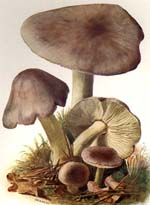 Key to Gilled Mushrooms Key
Key to Gilled Mushrooms KeyThis is a key to gilled mushrooms, that is, mushrooms having a definite cap with a fertile surface consisting of gills. The fruiting body usually also has a stem, although that may be lateral or absent (usually, then, the mushroom is growing from wood). You can use this key to identify mushrooms that you find.
 Agaricales Order
Agaricales OrderFruiting body containing fibers (usually in the stalk)
 White Spored Suborder
White Spored SuborderSpore print "light-colored": white or buff, sometimes tinged with pink or tan. Greenish and (except for the Russulales) yellow spore prints also go here
Stalk fibrous, not fracturing like a piece of chalk
 Tricholomataceae Family
Tricholomataceae FamilyNone of the special features distinguishing the other white-spored genera:
Gills not free, as in the Lepiotas and Amanitas
Basidia not extra-long, as in the Hygrophoraceae
Spores smooth, except for Lentinellus
 Terrestrial Trich Subfamily
Terrestrial Trich SubfamilyGrowing on the ground
 Woodland Normal Trich Tribe
Woodland Normal Trich TribeFound in woods
Not rooting
 Cystoderma Genus
Cystoderma GenusCap powdery
Stalk sheathed by a powdery armilla
Generally up to 2" across
Yellowish Cystoderma Section

Diagnosis
Narrow down your identification:
 Cystoderma amianthinum
Cystoderma amianthinumFlesh staining dark rusty brown with KOH or ammonia
On moss, needles or humus in conifer woods
Ring often incomplete, not very assertive
Cystoderma amianthinum var. rugosoreticulatumCap deeply wrinkled from center out
Flesh staining dark rusty brown with KOH or ammonia
On moss, needles or humus in conifer woods
With a strong odor, variously described as like newly husked corn or just "pungent"
Ring often incomplete, not very assertive
Cystoderma fallaxKnown from moss, needles or humus in conifer woods in the Pacific NW or the Great Lakes area
Cap surface turning black with KOH
Ring firm, often flaring
Cystoderma granosumFound on rotting hardwoods






 Key to Gilled Mushrooms Key
Key to Gilled Mushrooms Key Agaricales Order
Agaricales Order White Spored Suborder
White Spored Suborder Tricholomataceae Family
Tricholomataceae Family Terrestrial Trich Subfamily
Terrestrial Trich Subfamily Woodland Normal Trich Tribe
Woodland Normal Trich Tribe Cystoderma Genus
Cystoderma Genus
 Cystoderma amianthinum
Cystoderma amianthinum




